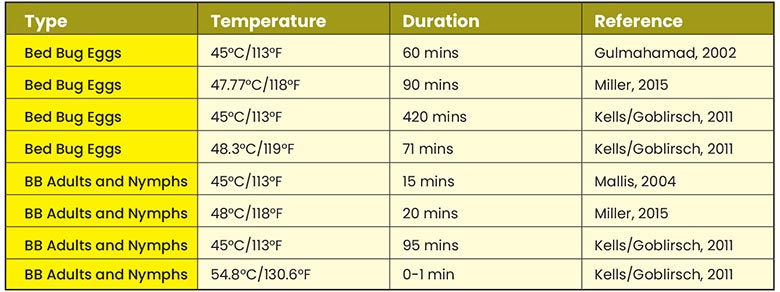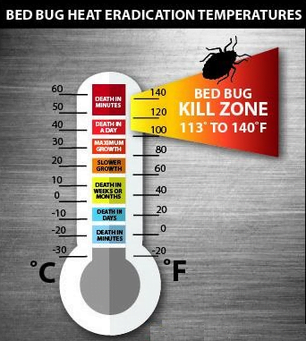Bed bugs can be killed at a temperature of 118°F (48°C) or higher. Exposing them to this level of heat for at least 20 minutes is generally effective.
Dealing with a bed bug infestation can be stressful. These tiny pests can be difficult to eliminate, and traditional methods may not always be effective. However, using heat treatment to kill bed bugs has become a popular and successful option for many homeowners.
By raising the temperature in the affected area to a level that is lethal to the bugs, heat treatment provides a non-toxic and environmentally friendly alternative to chemical pesticides. We will explore how hot it has to be to kill bed bugs and the benefits of using heat treatment to get rid of these persistent pests.

Credit: certifiedpestcontrol.com
Ideal Temperature For Killing Bed Bugs
If you’re dealing with a bed bug infestation, understanding the ideal temperature for killing bed bugs is crucial.
Effects Of Temperature On Bed Bugs
High temperatures can effectively eradicate bed bugs in all life stages, including eggs, nymphs, and adults. Extreme heat can disrupt their cellular structure, leading to mortality within a short period.
Optimal Heat Levels
The optimal temperature required to kill bed bugs is around 120-140°F (49-60°C). At this temperature, bed bugs can be eliminated in as little as 15 minutes of exposure, making it an efficient and environmentally friendly method.

Credit: convectex.com
Methods Of Heating To Kill Bed Bugs
When it comes to dealing with a bed bug infestation, one effective method is heating. Heat treatment, known as thermal remediation, involves using elevated temperatures to kill bed bugs. This method can be highly effective and has several benefits over traditional chemical treatments.
Benefits Of Heat Treatment
One of the primary benefits of using heat to eradicate bed bugs is its ability to penetrate deep into cracks, crevices, and furniture where bed bugs hide. This method can ensure full extermination, leaving no area untouched. Moreover, it is non-toxic, posing minimal risk to humans or pets. Additionally, heat treatment can be completed in a single visit, minimizing disruption to your home or business.
Comparison With Chemical Treatments
When comparing heat treatment with chemical methods, heat has several advantages. Unlike chemical pesticides, heat treatment does not leave behind any residues, eliminating the need for extensive cleaning after treatment. Furthermore, chemical treatments can be less effective against bed bug eggs, while heat can successfully eradicate eggs and adult bed bugs alike.
Professional Heat Treatment Vs. Diy Methods
In the battle against bed bugs, determining the most effective method for eradication is crucial. When it comes to Professional Heat Treatment vs. DIY Methods, it’s essential to weigh the pros and cons of each approach.
Cost Considerations
Professional heat treatment for bed bugs involves advanced equipment & expertise, resulting in higher costs. DIY methods, although cheaper, may not be as effective in exterminating the pests.
Safety Issues
Professional heat treatment is conducted by trained experts, ensuring safety protocols are followed to protect inhabitants. DIY methods may pose risks if not executed properly, potentially causing harm.

Credit: www.randrmagonline.com
Tips For Effective Heat Treatment
When it comes to getting rid of pesky bed bugs, heat treatment has proven to be one of the most effective methods. Heat treatment involves raising the temperature of the affected area to a level that is lethal to bed bugs, thus eliminating the infestation. In this article, we will delve into some important tips for executing an effective heat treatment to ensure a thorough eradication of these tiny pests.
Preparation Steps
Before you commence the heat treatment process, there are a few important steps you need to take to ensure maximum effectiveness. These steps will help to create a conducive environment for the heat treatment and ensure that the bed bugs have nowhere to hide:
- Remove all clutter and unnecessary items from the area that will be treated. This includes clothing, bedding, furniture, and any other objects that may provide hiding places for bed bugs.
- Thoroughly vacuum the entire area, paying extra attention to cracks, crevices, and upholstery. Dispose of the vacuum bag immediately after use to prevent any potential reinfestation.
- Seal off any cracks or openings in the walls, baseboards, or furniture to prevent bed bugs from escaping or reinfesting the area once the heat treatment begins.
- Make sure that all electrical appliances and outlets are turned off and unplugged. This is crucial to ensure the safety of the heat treatment process.
- Open up drawers, closets, and cabinets to allow the heat to penetrate every nook and cranny of the infested area.
- Consider removing any pets or plants from the area temporarily as they may be sensitive to high temperatures.
Post-treatment Measures
After the heat treatment process has been completed, it is important to follow these measures to prevent any potential reinfestation:
- Thoroughly inspect all treated areas to make sure there are no signs of bed bugs or eggs. Use a flashlight and magnifying glass if necessary.
- Continue to vacuum the area regularly to remove any dead bed bugs or eggs that may have been missed during the initial treatment.
- Consider applying residual insecticides or bed bug powders as a preventive measure to ensure any remaining bed bugs are eliminated.
- Wash all bedding, clothing, and linens in hot water and dry them on high heat to kill any potential hitchhiking bed bugs.
- Be vigilant in monitoring for any signs of bed bugs in the weeks following the heat treatment. Early detection is key in preventing a reinfestation.
By following these preparation steps and post-treatment measures, you can ensure that your heat treatment is effective in eliminating the bed bug infestation and preventing future outbreaks. Remember, heat treatment can reach temperatures upwards of 120 degrees Fahrenheit, so proper precautions and safety measures should always be taken. Don’t let bed bugs ruin your peace of mind – take action and get rid of them with the power of heat!
Factors Affecting Heat Treatment Success
When it comes to eliminating bed bugs from your home, heat treatment has proven to be one of the most effective methods. However, the success of heat treatment depends on various factors. Understanding these factors can help you ensure that the treatment is carried out accurately and efficiently. In this article, we will explore the three key factors that can impact the success of heat treatment: Inspection Accuracy, Severity of Infestation, and Proper Preparation.
Inspection Accuracy
Before undertaking any heat treatment, it is crucial to have a thorough inspection to accurately identify all bed bug hiding spots. Bed bugs are elusive creatures, capable of squeezing into the tiniest cracks and crevices. A comprehensive inspection ensures that every hiding place is targeted during the heat treatment.
An experienced professional should conduct the inspection, as they have the knowledge and expertise to identify even the most inconspicuous hiding spots. This includes not only typical areas such as mattresses and headboards but also less obvious places like electrical outlets, wall voids, and furniture joints.
Severity Of Infestation
The severity of a bed bug infestation can significantly impact the effectiveness of heat treatment. If the infestation is mild or localized, heat treatment alone may be sufficient to eradicate the pests. However, in more severe infestations, additional treatments may be necessary.
In cases of significant infestation, it is recommended to combine heat treatment with other methods, such as insecticide application or steam treatment. This multi-pronged approach ensures that all bed bugs, regardless of their life stage or location, are effectively eliminated.
Proper Preparation
Proper preparation is vital to the success of heat treatment. Before the treatment, it is essential to remove all items that may be sensitive to high heat, such as electronics, pets, and plants. Additionally, clutter should be minimized to allow for optimal heat penetration throughout the space.
Properly preparing the area also involves sealing cracks, gaps, and other potential entry points for bed bugs. This prevents the pests from escaping the heat treatment and re-infesting the area once the treatment is complete.
Overall, accurate inspection, the severity of the infestation, and proper preparation are crucial factors that can affect the success of heat treatment in eliminating bed bugs. By addressing these factors, you can ensure that the heat treatment effectively eradicates the infestation, allowing you to regain control of your home.
Common Misconceptions About Bed Bug Heat Treatment
Bed bug heat treatment misconceptions often focus on the temperature required to effectively eliminate the pests. Contrary to popular belief, it must reach 120-135°F to fully eradicate bed bugs at all life stages. This high heat obliterates the entire infestation, ensuring complete eradication.
Myth Debunking
Many people have misconceptions about how hot it needs to be to kill bed bugs. Let’s clear up some common myths about bed bug heat treatment.
Realistic Expectations
Understanding what to realistically expect from bed bug heat treatment is important for effective pest control. Here are some key points:
- Bed bugs start to die at temperatures above 113°F
- Sustained heat of around 120-140°F is needed for complete eradication
- Heat treatment typically lasts for several hours to ensure thorough elimination
It’s crucial to dispel these myths and have realistic expectations when dealing with bed bug infestations.
Frequently Asked Questions For How Hot Does It Have To Be To Kill Bed Bugs?
How Hot Does It Have To Be To Kill Bed Bugs?
Bed bugs can be effectively killed at temperatures above 113°F, as their bodies cannot tolerate such heat. It is recommended to use hot steam, clothes dryers, or professional heating equipment to reach these temperatures and eliminate bed bugs from infested areas.
Does Freezing Temperatures Kill Bed Bugs?
Yes, freezing temperatures can kill bed bugs. Bed bugs are susceptible to temperatures below 0°F (-18°C) and can die within a few hours if exposed to extreme cold. Placing infested items in a freezer for a minimum of four days can effectively kill bed bugs and their eggs.
Can Cold Weather Keep Bed Bugs Away?
Cold weather does not necessarily keep bed bugs away. While extreme cold can kill bed bugs, they are resilient and can survive in cooler temperatures. Bed bugs are known to thrive in indoor environments, so proper prevention measures and regular inspections are crucial in keeping them away regardless of the weather.
Conclusion
To effectively eradicate bed bugs, understanding the right temperature is crucial. While heat can be a powerful tool in killing bed bugs, it’s essential to ensure the temperature reaches the necessary threshold for complete eradication. By following proper guidelines, you can successfully eliminate these stubborn pests from your home.
Related posts:

I’m MD Tanvir, and I bring years of expertise gained from working closely with pest control companies to the forefront. My journey in the industry has inspired me to launch Bug Battler, a platform aimed at equipping people with the know-how to combat pests autonomously. Through Bug Battler, I aim to empower individuals with practical insights to tackle pest infestations effectively.

